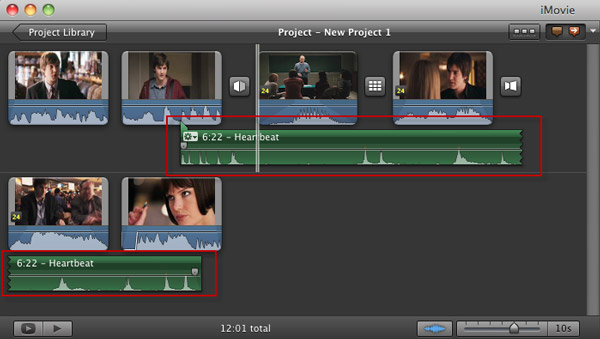

- #TURNING ON AUDIO BAR IN IMOVIE HOW TO#
- #TURNING ON AUDIO BAR IN IMOVIE SOFTWARE#
- #TURNING ON AUDIO BAR IN IMOVIE DOWNLOAD#
- #TURNING ON AUDIO BAR IN IMOVIE MAC#
Step 2: Choose Where You Want to Fade Music Placing the cursor over the audio display will reveal the two fade handles.
#TURNING ON AUDIO BAR IN IMOVIE MAC#
Open the iMovie application on your Mac and position the cursor over the timeline in your clip's audio display.
#TURNING ON AUDIO BAR IN IMOVIE HOW TO#
Here's how to fade out music in iMovie: Step 1: Open the Fade Handles
:max_bytes(150000):strip_icc()/1musicpane-5806b9323df78cbc2845ec24.jpg)
The iMovie fade audio tool provides top-quality sounding videos but using the feature can be clumsy at times.
#TURNING ON AUDIO BAR IN IMOVIE DOWNLOAD#
If you don't have the application, you can always download it free from the App Store.
#TURNING ON AUDIO BAR IN IMOVIE SOFTWARE#
IMovie is a free video editing software that comes pre-installed on Mac computers. #fisheye effect VERY SLOW!!! if used make change the size of the spectrum to (1920*11/10)x(1080*11/10) and use the crop filter belowįilter4="frei0r=filter_name=defish0r:filter_params=1.How to Fade-in / Fade-out Audio in iMovie Remote_command="youtube-upload -title=\"Remote_upload\" -privacy=\"private\" $upload_location$outfile"įilter1="showspectrum=s=1920x1080:slide=scroll:mode=combined:color=intensity:scale=cbrt:saturation=1:win_func=hann"įilter2="crop=iw:ih/2:0:ih/2-3,split vflip vstack"įilter3="crop=iw/2:ih:iw/2:,split hflip hstack" It also uses the great script youtube-upload!ĮDIT: uploading directly slows down the encoding process significantly!! Script #!/bin/bash I also added an upload option for myself to encode directly to my remote server that has a better connection than at home to upload big videos. Or you can follow a step-by-step guide to compile ffmpeg.Īfter reading the great answer from LordNeckbeard I went on created a small script to make a visualization with ffmpeg and the showspectrum filter. Links to builds of ffmpeg for Windows, OS X, and Linux are available on the FFmpeg Download page. You should always use a recent version since development is very active. Think of stream copying (re-muxing) like a copy and paste – no re-encoding. Instead of re-encoding by default, you can use -c:a copy to stream copy the audio if your output container format supports the audio format. See FFmpeg Wiki: H.264 Encoding Guide for more detailed information regarding output quality.įormat=yuv420p makes sure that libx264 uses a pixel format that is compatible with crappy players like QuickTime. See the showvolume documentation for more options and examples. See the showwaves documentation for more options and examples.Ĭonvert input audio volume to a video output.įfmpeg ffmpeg -i input.mka -filter_complex \ "showwaves=s=1280x720:mode=line:rate=25,format=yuv420p" \įfplay ffplay -f lavfi "amovie=input.m4a, asplit showwaves " See the showspectrum documentation for more options and examples.Ĭonvert input audio to a video output, representing the samples waves.įfmpeg ffmpeg -i input.m4a -filter_complex \ showspectrum=mode=separate:color=intensity:slide=1:scale=cbrt " "showspectrum=s=1280x720,format=yuv420p" \įfplay ffplay -f lavfi "amovie=input.oga, asplit \ See the showfreqs documentation for more options and examples.Ĭonvert input audio to a video output, representing the audio frequency spectrum.įfmpeg ffmpeg -i input.oga -filter_complex \ "showfreqs=mode=line:fscale=log,format=yuv420p" \įfplay ffplay -f lavfi "amovie=input.mp4, asplit showfreqs=mode=line:fscale=log "

Audio amplitude is on Y-axis while frequency is on X-axis. See the showcqt documentation for more options and examples.Ĭonvert input audio to video output representing the audio power spectrum. See the avectorscope documentation for more options and examples.Ĭonvert input audio to a video output representing frequency spectrum with musical tone scale.įfmpeg ffmpeg -i input.mp4 -filter_complex \įfplay ffplay -f lavfi "amovie=input.mp4, asplit showcqt " "avectorscope=s=1280x720,format=yuv420p" \įfplay ffplay -f lavfi "amovie=input.mp3, asplit \ See the aphasemeter documentation for more options and examples.Ĭonvert input audio to a video output, representing the audio vector scope.įfmpeg ffmpeg -i input.mp3 -filter_complex \ "aphasemeter=s=1280x720:mpc=cyan,format=yuv420p" \įfplay ffplay -f lavfi "amovie=input.wav, asplit aphasemeter=s=1280x720:mpc=cyan " See the ahistogram documentation for more options and examples.Ĭonvert input audio to a video output, displaying the audio phase.įfmpeg ffmpeg -i input.wav -filter_complex \

You can use ffmpeg to create video from audio using several filters.Ĭonvert input audio to a video output, displaying the volume histogram.įfmpeg ffmpeg -i input.flac -filter_complex \įfplay ffplay -f lavfi "amovie=input.flac, asplit ahistogram "


 0 kommentar(er)
0 kommentar(er)
